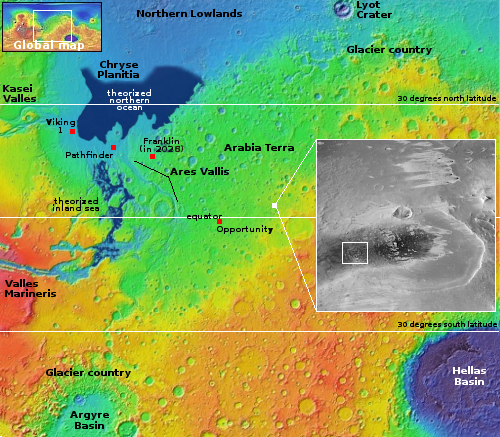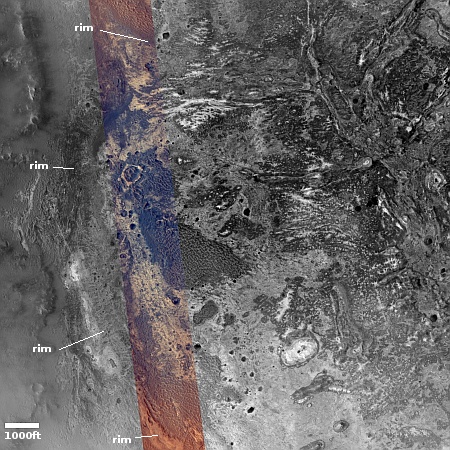Another “what the heck?” image from Mars
Cool image time! The picture to the right, cropped, reduced, and sharpened to post here, was taken on April 14, 2024 by the high resolution camera on Mars Reconnaissance Orbiter (MRO), and shows what the scientists simply label as “exposed crater floor materials.”
I label it as another one of my “what the heck?” images, showing features that in some ways defy understanding or explanation. The picture shows a small area of the floor of an unnamed 14-mile-wide crater, with its rim indicated. Though clearly visible in orbital photos, the crater is nonetheless heavily eroded and even appears partly buried, possibly by flood lava.
The complex floor features however are not anything usually seen in flood lava terrains. The terrain colored blue in the color strip likely indicates coarse material like sand or rocks or rough bedrock, while the reddish terrain suggests the surface is heavily coated with dust.

The white dot on the overview map to the right marks the location, in the dry tropics of Mars and about 600 miles east of the region explored by the rover Opportunity.
The inset shows that the prevailing winds in this region blow from the east to the west. Inside the crater winds have apparently ripped off the top layers, exposing this strange terrain underneath and blowing dark material to the west.
The colors in the picture above strengthen this conclusion, as the dark blue material appears like rough eroded rock while the surrounding terrain is covered by ordinary red Martian dust. That dark rock and sand is possibly very old lava material that is now exposed and being broken apart and blown away by the winds.
Why however is that exposed material so twisted with bright and dark sections? I haven’t the faintest idea.
On Christmas Eve 1968 three Americans became the first humans to visit another world. What they did to celebrate was unexpected and profound, and will be remembered throughout all human history. Genesis: the Story of Apollo 8, Robert Zimmerman's classic history of humanity's first journey to another world, tells that story, and it is now available as both an ebook and an audiobook, both with a foreword by Valerie Anders and a new introduction by Robert Zimmerman.
The print edition can be purchased at Amazon or from any other book seller. If you want an autographed copy the price is $60 for the hardback and $45 for the paperback, plus $8 shipping for each. Go here for purchasing details. The ebook is available everywhere for $5.99 (before discount) at amazon, or direct from my ebook publisher, ebookit. If you buy it from ebookit you don't support the big tech companies and the author gets a bigger cut much sooner.
The audiobook is also available at all these vendors, and is also free with a 30-day trial membership to Audible.
"Not simply about one mission, [Genesis] is also the history of America's quest for the moon... Zimmerman has done a masterful job of tying disparate events together into a solid account of one of America's greatest human triumphs."--San Antonio Express-News
Cool image time! The picture to the right, cropped, reduced, and sharpened to post here, was taken on April 14, 2024 by the high resolution camera on Mars Reconnaissance Orbiter (MRO), and shows what the scientists simply label as “exposed crater floor materials.”
I label it as another one of my “what the heck?” images, showing features that in some ways defy understanding or explanation. The picture shows a small area of the floor of an unnamed 14-mile-wide crater, with its rim indicated. Though clearly visible in orbital photos, the crater is nonetheless heavily eroded and even appears partly buried, possibly by flood lava.
The complex floor features however are not anything usually seen in flood lava terrains. The terrain colored blue in the color strip likely indicates coarse material like sand or rocks or rough bedrock, while the reddish terrain suggests the surface is heavily coated with dust.

The white dot on the overview map to the right marks the location, in the dry tropics of Mars and about 600 miles east of the region explored by the rover Opportunity.
The inset shows that the prevailing winds in this region blow from the east to the west. Inside the crater winds have apparently ripped off the top layers, exposing this strange terrain underneath and blowing dark material to the west.
The colors in the picture above strengthen this conclusion, as the dark blue material appears like rough eroded rock while the surrounding terrain is covered by ordinary red Martian dust. That dark rock and sand is possibly very old lava material that is now exposed and being broken apart and blown away by the winds.
Why however is that exposed material so twisted with bright and dark sections? I haven’t the faintest idea.
On Christmas Eve 1968 three Americans became the first humans to visit another world. What they did to celebrate was unexpected and profound, and will be remembered throughout all human history. Genesis: the Story of Apollo 8, Robert Zimmerman's classic history of humanity's first journey to another world, tells that story, and it is now available as both an ebook and an audiobook, both with a foreword by Valerie Anders and a new introduction by Robert Zimmerman.
The print edition can be purchased at Amazon or from any other book seller. If you want an autographed copy the price is $60 for the hardback and $45 for the paperback, plus $8 shipping for each. Go here for purchasing details. The ebook is available everywhere for $5.99 (before discount) at amazon, or direct from my ebook publisher, ebookit. If you buy it from ebookit you don't support the big tech companies and the author gets a bigger cut much sooner.
The audiobook is also available at all these vendors, and is also free with a 30-day trial membership to Audible.
"Not simply about one mission, [Genesis] is also the history of America's quest for the moon... Zimmerman has done a masterful job of tying disparate events together into a solid account of one of America's greatest human triumphs."--San Antonio Express-News



Perhaps Richard Hoagland and his team can help you figure it out.
Maybe you should do a top ten WTH Mars geology mystery pics post sometime.? You cover these periodically, would be interesting to see a back to back of the best ones from these many years.
Ryan Lawson: First: I have edited your comment slightly, since your acronym for my “What the heck” images instead implied I used an obscenity instead. Why would you do that?
Second, you make an excellent suggestion. I’ll think about it. Right now I am trying to get back up to speed after my break the past few days.